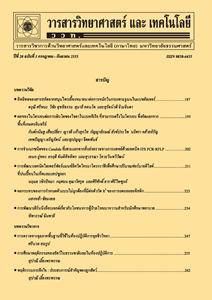Antibacterial, Antioxidant and Anticancer Activities of the Caesalpinia sappan L. Extract
Main Article Content
Abstract
The purposes of this research were to investigate antibacterial activity, antioxidant activity and anti-cancer activities against human cell lines, KB oral cavity cancer and NCI-H187 small lung cancer of the methanolic extract of Caesalpinia sappan Linn. heartwood. The antibacterial activity was examined by using agar well diffusion method. The antioxidant activity was determined using DPPH radical scavenging assay. The anti-cancer activities against KB oral cavity cancer and NCI-H187 small lung cancer were analyzed by the Bio-resources Technology Unit (BTU), National Center for Genetic Engineering and Biotechnology (BIOTEC). The research results were that the methanolic extract of C. sappan heartwood exhibited strong antibacterial activities against Staphylococcus aureus (ATCC25923), Salmonella Typhimurium (ATCC13311) and Vibrio cholera (non 01, non 0139, DMST2873) with MIC values of 0.313, 0.500 and 0.625 mg/mL, respectively. For analyzing the antioxidant activity, it was found that the methanolic extract was about 13.15 times higher antioxidant activity (IC50 = 35.26±2.08 µg/mL) than that of BHT (butylated hydroxytoluene) standard (IC50 = 463.70±34.20 µg/mL). Moreover, the methanolic extract at a concentration of 50 µg/mL exhibited anti-cancer activities against human cell lines, KB oral cavity cancer and NCI-H187 small lung cancer with inhibition activities of 78.08 and 80.75 %, respectively.
Article Details
References
Nirmal, N.P., Rajput, M.S., Prasad, R.G.S.V. and Ahmad, M., 2015, Brazilin from Caesalpinia sappan heartwood and its pharmacological activities: A review, Asian Pac. J. Trop. Biomed. 8: 421-430.
Batubara, I., Mitsunaga, T. and Ohashi, H., 2010, Brazilin from Caesalpinia sappan wood as an antiacne agent, J. Wood Sci. 56: 77-81.
Nguyen, M.T.T., Awale, S., Tezuka, Y., Tran, Q.L. and Kadota, S., 2005, Xanthine Oxidase Inhibitors from the Heartwood of Vietnamese Caesalpinia sappan, Chem. Pharm. Bull. 53: 984-988.
Wu, S.Q., Otero, M., Ungera, F.M., Goldring, M.B., Phrutivorapongkul, A., Chiari, C., Kolb, A., Viernstein, H. and Toegel, S., 2011, Anti-inflammatory activity of an ethanolic Caesalpinia sappan extract in human chondrocytes and macrophages, J. Ethnopharmacol. 138: 364-372.
Nirmal, N.P. and Panichayupakaranant, P., 2015, Antioxidant, antibacterial, and anti-inflammatory activities of standardized brazilin-rich Caesalpinia sappan extract, Pharm. Biol. 53: 1339-1343.
Wetwitayaklung, P., Phaechamudb, T. and Keokitichaic, S., 2005, The antioxidant activity of Caesalpinia sappan L. heartwood in various ages, Naresuan Univ. J. 13: 43-52.
Kim, K.J., Yu, H.H., Jeong, S.I., Cha, J.D., Kim, S.M. and You, Y.O., 2004, Inhibitory effects of Caesalpinia sappan on growth and invasion of methicillin-resistant Staphylococcus aureus, J. Ethnopharma col. 91: 81-87.
Lim, M.Y., Jeon, J.H., Jeong, E.Y., Lee, C.H. and Lee, H.S., 2007, Antimicrobial activity of 5-hydroxy-1,4-naphthoquinone isolated from Caesalpinia sappan toward intestinal bacteria, Food Chem. 100: 1254-1258.
Kang, S.N., Do, J.R., Kim, K.J., Jo, J.H. and Lee, S.W., 2004, Antimicrobial and antioxidant activities and phenolic contents in the water extract of medicinal plants, Food Sci Biotechnol. 13: 640-645.
Pham-Huy, L.A., He, H. and Pham-Huy, C., 2008, Free radicals, antioxidants in disease and health, Int. J. Biomed. Sci. 4: 89-96.
Badami, S., Moorkoth, S., Rai, S.R., Kannan, E. and Bhojraj, S., 2003, Antioxidant activity of Caesalpinia sappan heartwood, Biol.
Pharm. Bull. 26: 1534-1537.
Yingming, P., Ying, L., Hengshan, W. and Min, L., 2004, Antioxidant activities of several Chinese medicine herbs, Food Chem. 88: 347-350.
Parekh, J. and Chanda, S., 2006, In vitro antimicrobial activities of extracts of Launaea procumbens Roxb. (Labiateae), Vitis vinifera L. (Vitaceae) and Cyperus rotundus L. (Cyperaceae), Afr. J. Biomed. Res. 9: 89-93.
Sana, H., Sabitha Rani, A. and Sulakshana, G., 2014, Determination of antioxidant potential in Spilanthes acmella using DPPH assay, Int. J. Curr. Microbiol. Appl. Sci. 3: 219-223.
Javanmardi, J., Stushnoff, C., Locke, E. and Vivanco, J.M., 2003, Antioxidant activity and total phenolic content of Iranian Ocimum accessions, Food Chem. 83: 547-550.
Alzoreky, N.S. and Nakahara, K., 2003, Antibacterial activity of extracts from some edible plants commonly consumed in Asia, Int. J. Food Microbiol. 80: 223-230.
Maregesi S.M., Pieters, L., Ngassapa, O.D., Apers, S., Vingerhoets, R., Cos, P., Vanden Berghe, D.A. and Vlietinck, A.J., 2008, Screening of some Tanzanian medicinal plants from Bunda district for antibacterial, antifungal and antiviral
activities, J. Ethnopharmacol. 119: 58-66.
Gritsanapan, W. and Chulasiri, M., 1983, A preliminary study of antidiarrheal plants: I, antibacterial activity, Mahidol Univ. J. Pharm. Sci. 10: 119-122.
Nirmal, N.P. and Panichayupakaranant, P., 2015, Antioxidant, antibacterial, and anti-inflammatory activities of standardized brazilin-rich Caesalpinia sappan, Pharm. Biol. 53: 1339-1343.
Hikino, H., Toguchi, T., Fujimura, H. and Hiramatsu, Y., 1977, Antiinflammatory principles of Caesalpinia sappan wood and of Haematoxylon campechianum wood, Plant. Med. 31: 214-220.
Xie, Y.W., Ming, D.D., Xu, H.X., Dong, H. and But, P.P., 2000, Vasorelaxing effects of Caesalpinia sappan involvement of endogenous nitric oxide, Life Sci. 67: 1913-1918.
Jun, H., Xiaoling, Y., Wei, W., Hao, W., Lei, H. and Lijun, D., 2008, Antioxidant activity in vitro of three constituents from Caesalpinia sappan L., Tsinghua Sci. Technol. 13: 474-479.
Ueda, J.Y., Tezuka, Y., Banskota, A.H., Tran, Q.L., Tran, Q.K., Harimaya, Y., Saiki, J. and kadota, S., 2002, Antiproliferative activity of Vietnamese medicinal plants, Biol. Pharm. Bull. 25: 753-760.


